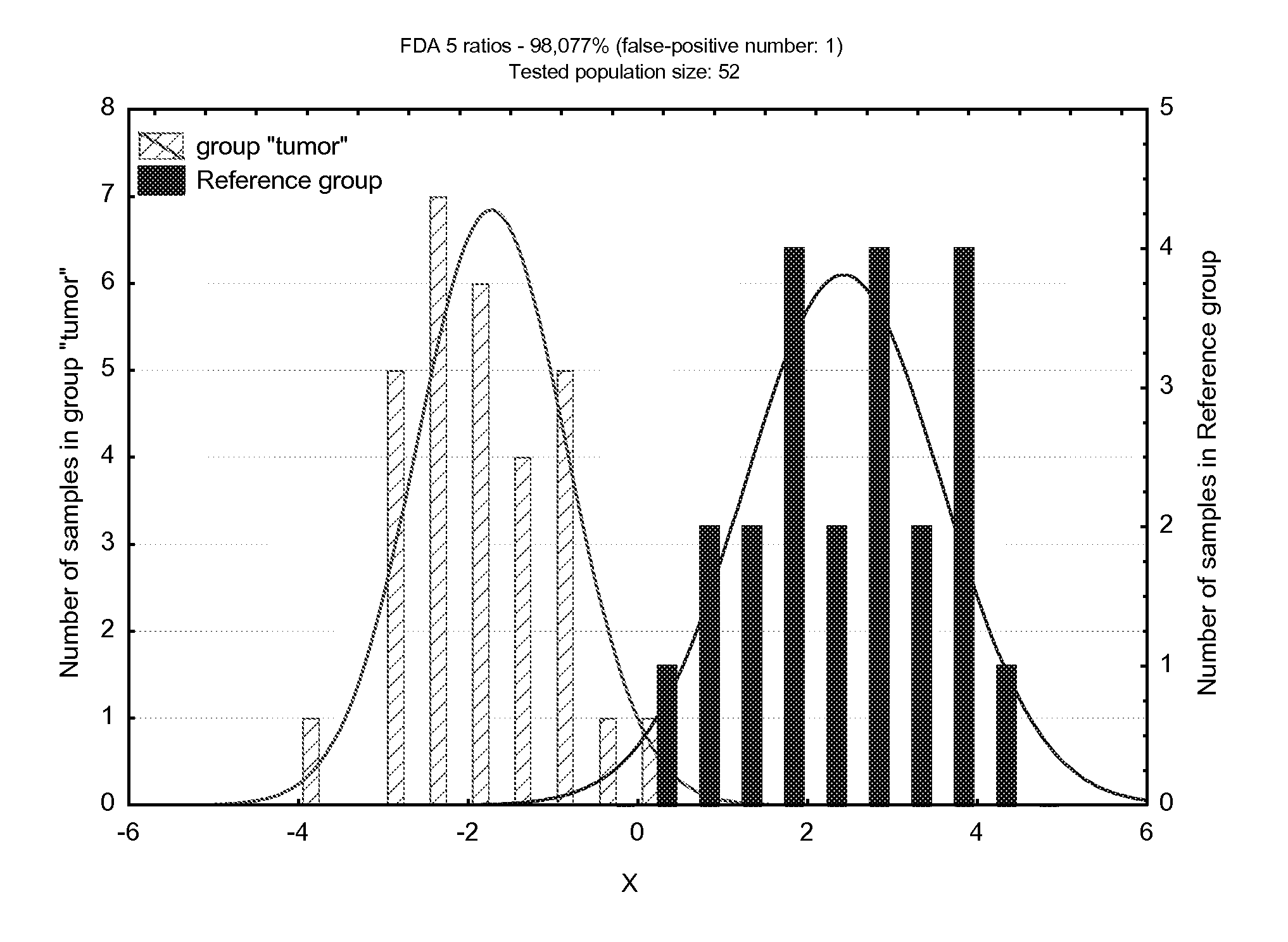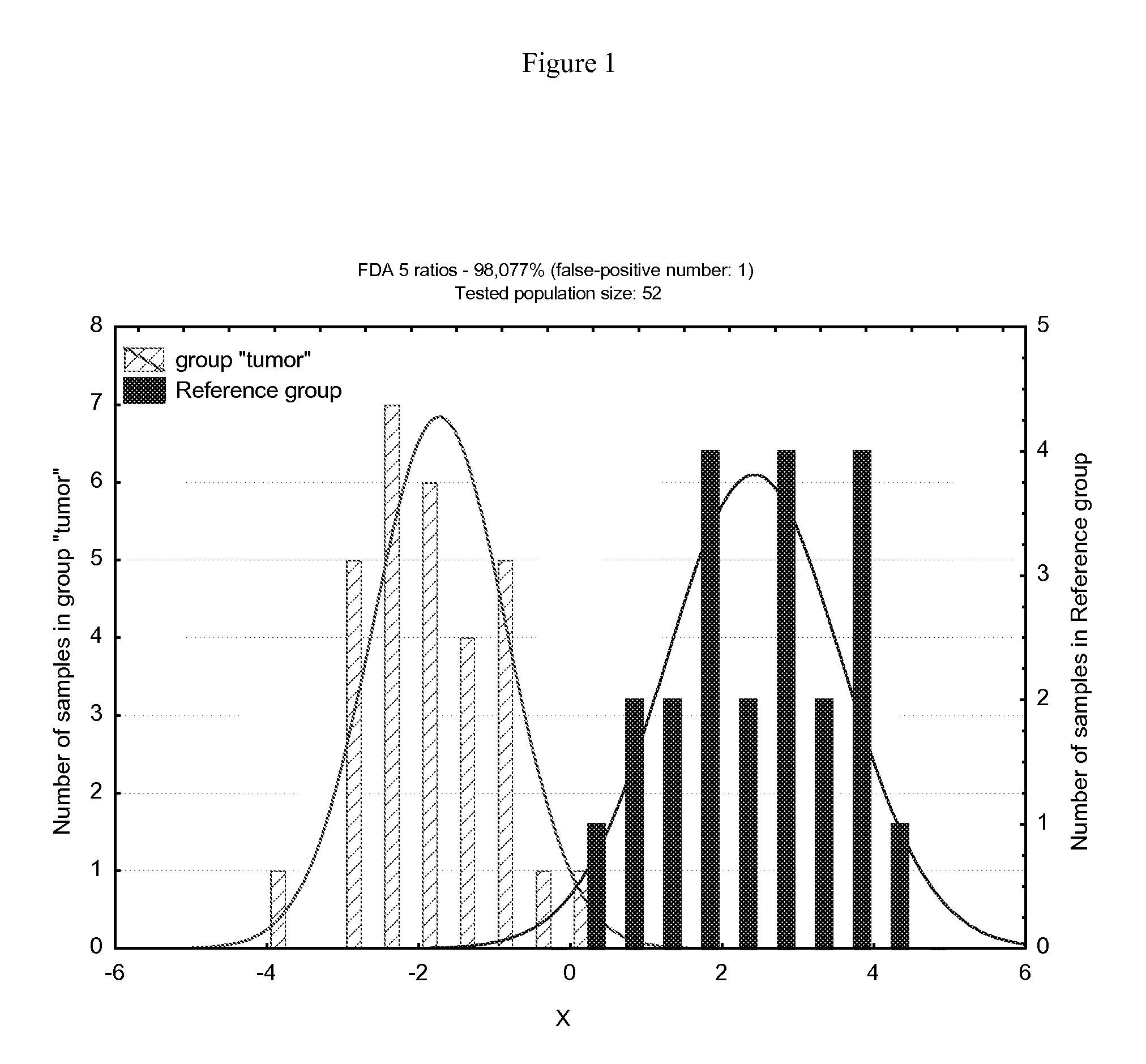Method of evaluating oral cancer risk in human
a human and oral cancer technology, applied in the field of human oral cancer risk evaluation, can solve the problems of not being able to predict from li et al, the overall 5-year survival rate has not improved in the past several decades, and the association of particulate bacteria strains with oral cancer is not good
- Summary
- Abstract
- Description
- Claims
- Application Information
AI Technical Summary
Problems solved by technology
Method used
Image
Examples
example 2
Simultaneous Determination and Quantification in Stabilized Saliva of the Presence of Bacteria, Virus and Human mRNA to Assess Risk Factor of Oral Cancer
[0167]0.250 to 3 ml of the solution from tube 1 is prepared and total nucleic acids are extracted by centrifiltration on a silica membrane without DNAse step. Up to 1.5 mg of total nucleic acid are extracted and purified from 1 ml of stabilized saliva.
[0168]Isolation of high-quality DNA and RNA from whole saliva samples is difficult because under ambient conditions, expression and quantification profile are unstable on a timescale below few minutes. This instability is the result of metabolic activity of bacteria, nutrients dependant, concentration in nucleases and limited turnover of RNA in that environmental conditions. In order to render the nucleic acid inaccessible to nuclease, we used a preservation buffer which comprises a salt for membrane lysis of bacteria as well as human cells and precipitates the extracted nucleic acid i...
example 3
Analysis of Genetic Markers in the Fluid Fraction by More than 2 Separate Steps
[0186]1—The saliva sample (up to 1000 μL) is mixed with a diluting buffer (sterile nuclease free reagent) and passed through a sterile polyethylene terephtalate (PET) plastic tube. Preservative reagent and a known nucleic acid (pure synthetic ribonucleotide) are calibrated to draw up to 3 ml of saliva associated with the dilution buffer. Full process should be realized in less than 2 minutes. This process permits immediate preservation of total nucleic acids at room temperature for up to 10 days to allow transportation delays via regular mail to laboratory.
[0187]2—Lysis at laboratory, transfer up to 1000 μl of liquid from the PET plastic into a 2 mL sterile tube with up to 1 mL of lysis buffer and then incubate at 35° C.+ / −2° C. for up to one hour.
[0188]3—The lysat is processed for total nucleic acids purification with magnetic silica or polystyrene beads or funnel-design having silica membrane in mini pr...
example 4
Analysis of the Fluid Fraction of Saliva Sample Using Microarrays
[0189]1—The saliva sample (up to 1000 μL) is mixed with a diluting buffer (sterile nuclease free water) and passed through a sterile polyethylene terephtalate (PET) plastic tube. Preservative reagent and a known nucleic acid (pure synthetic ribonucleotide) are calibrated to draw up to 3 ml of saliva associated with the dilution buffer. Full process should be realized in less than 2 minutes. This process permits immediate preservation of total nucleic acid at room temperature for up to 10 days to allow transportation delays via regular mail to laboratory.
[0190]2—Lysis at laboratory, transfer up to 1000 μl of liquid from the PET plastic into a 2 mL sterile tube with up to 1 mL of lysis buffer and then incubate at 35° C.+ / −2° C. for up to one hour.
[0191]3—The lysat is processed for total nucleic acids purification with magnetic silica or polystyrene beads or funnel-design having silica membrane in mini prep spin columns a...
PUM
| Property | Measurement | Unit |
|---|---|---|
| Temperature | aaaaa | aaaaa |
| Fraction | aaaaa | aaaaa |
| Volatility | aaaaa | aaaaa |
Abstract
Description
Claims
Application Information
 Login to View More
Login to View More - R&D
- Intellectual Property
- Life Sciences
- Materials
- Tech Scout
- Unparalleled Data Quality
- Higher Quality Content
- 60% Fewer Hallucinations
Browse by: Latest US Patents, China's latest patents, Technical Efficacy Thesaurus, Application Domain, Technology Topic, Popular Technical Reports.
© 2025 PatSnap. All rights reserved.Legal|Privacy policy|Modern Slavery Act Transparency Statement|Sitemap|About US| Contact US: help@patsnap.com


